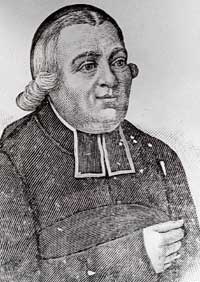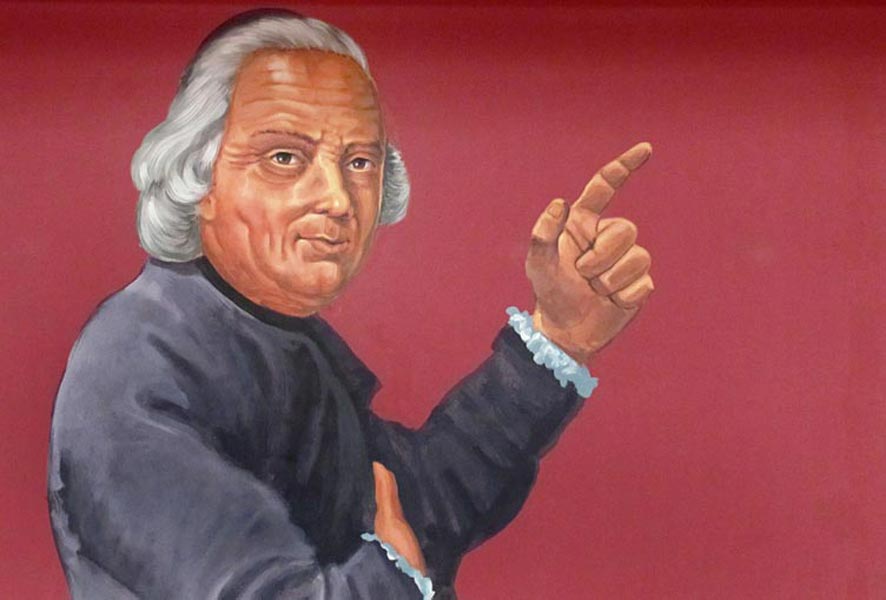Charles-Michel de l'Épée
Abbé Charles -Michel de l' Epée (* November 25, 1712 in Versailles, † December 23, 1789 in Paris) was a pioneer of deaf education.
Life and work
Charles -Michel de l' Epée first studied theology. Since he refused to sign a signature for condemnation of Jansenism, was denied by the Archbishop of Paris, the consecration. He then studied law, but was not allowed in this area rather than to him ordained Jacques Bénigne Bossuet, bishop of Troyes. Because of these died soon afterwards, the nunmehrige Abbé de l' Epée returned to Paris, where he used mainly as an advocate for the needs of the poorer sections of society because of his philanthropic spirit.
In 1760 his two deaf sisters were presented in childhood, their educators, Père Vanin, had just died. He took the sisters to live with him in the house and taught them instead of Vanin on. He suspected that the gestures that his charges among themselves used, directly representing their ideas. From this observation and the idea of a nature- education ( Rousseau ) following he used in the classroom that agent which nature had been so apparent the " deaf and dumb ": sign language.
The Abbé de l' Epée, as it is usually called for short, was planning soon to bring more deaf children in the surrounding neighborhoods of the road and to inform and founded in 1771 to the Institution Nationale des Sourds - muets de Paris. It is usually regarded as the world's first school for the deaf.
Abbé de l' Epée followed the view of Descartes, that language is a sign system that exists outside of man. It is therefore possible thing and arbitrary character to connect with each other in every way, including matter and gesture. From this idea he developed from the observed of him, " natural gesture sign" with additional enhancements by grammatical characters a system of " methodical signs".
While the gesture comes from the nature of the pigeons, the font for the culture language ( spoken language ) of the hearing should lead. For learning the letters, and later also for dictating proper names, finger spelling occurs ( l' alphabet manually ) as an aid added. The students thought this language and expressed themselves in the same. Thus they reached a high level of knowledge, but were in traffic with hearing people continue to rely on intermediaries.
1776 gave de l' Epée institution of sourds - muets par la voie of signes méthodiques and 1784 La véritable manière d' instruire les sourds et muets, confirmée par une longue expérience out and started a general lexicon of sign character of his successor, Abbot Sicard, was completed.
Two years after his death, the National Assembly decreed its inclusion in the list of " benefactors of humanity " and the state support of his School. 1838, a bronze bust was erected over his grave in the church of Saint -Roch in Paris.
Assessment
Abbé de l' Epée ignored knowingly or unknowingly in its targeted efforts that the actual sign language, as it was used on the streets of Paris by the " deaf and dumb ", had very different structures, which it later by his former pupil Pierre Desloges in his Scripture was accused of in 1779. It can be assumed that the Abbé de l' epees " methodical signs" by the addition of grammatical character and based on the French grammar corresponds to about, which is in contrast to the real sign language as spoken language accompanying gestures (LBG ) is understood today.
However, his method was far more successful than the other, for example by Jacob Rodrigues Pereira, much earlier, in 1749 a single deaf student to speak and could bring him the Academy in Paris. De l' epees methods were later replaced by better ones, yet remains to him that in Germany he laid the foundations for a systematic education of the hearing impaired with his methods later in the dispute as " French method " has become known teaching system alongside Samuel Heinicke. Since Laurent Clerc student and assistant teacher at the Paris National Institute was before he went to the USA, de l' Epée also influenced the development in the United States (see also: History of the Deaf ).
- Teacher (18th century)
- Deafness
- Frenchman
- Born in 1712
- Died in 1789
- Man










